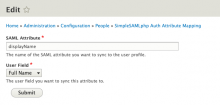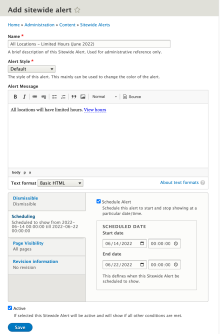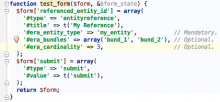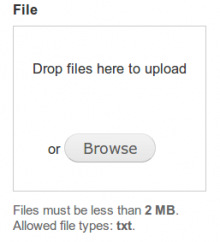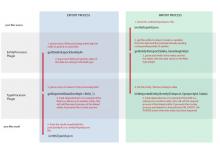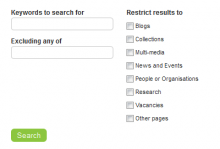Add functionality and customize your Drupal application with thousands of projects contributed by our amazing community.
A module is code that extends Drupal's by altering existing functionality or adding new features. You can use modules contributed by others or create your own. Learn more about creating and using Drupal modules.
All the Twig features you missed until now.
A Drupal powered module.
Makes it possible to connect and sign in a Drupal user with accounts on most third party sites with OAuth API:s.
Provides a UI for adding and editing specifications of OAuth API:s that the users should be able to connect to. Also provides exportability of those specifications.
Is an implementation of the Connector module.
The PHPExcel module allows developers to export/import data to/from real Excel files.
The idea behind this module is to have a single module for handling the export or import of Excel files, instead of multiple modules handling specific cases.
The 4.0.x version uses the composer to automatically manage dependencies. You just need to use the composer to download this module, it will automatically handle the dependence.
It provides a very simple way for developers to use it.
$phpexcel = \Drupal::service('phpexcel');
$filepath = 'modules/contrib/phpexcel/tests/src/Functional/data/phpexcel.test.multi_sheet.xlsx';
$result = $phpexcel->import($filepath);
What does this module do?
Most PDF modules generate PDFs from scratch; FillPDF is not one of those modules. Instead, it lets you fill in existing editable PDFs with data from your Drupal site. Editable PDFs are those forms that let you type into them.
Access control for user roles based on taxonomy categories (vocabulary, terms).
The Sitewide Alert module adds the ability to show alerts at the top of your site.
This module defines a new form element type, called "entityreference", that allows developers to add autocomplete fields to forms, so that users can reference any entity in the same way they would do through an Entity Reference field.
Right now, it supports:
- Filtering by Entity type (mandatory)
- Filtering by bundle (Any number of them)
- Limit to a maximum number of referenced entities (optional).
The following features might be added soon:
- Filtering by any column of the entity table (instead of just the label).
- Filtering by the value of any field of the entity.
For an example of usage, see the pictures attached, or check the README.txt file.
Modules with similar features:
Exclude nodes from indexing by Search API with the hook hook_search_api_query_alter().
Use case
If you want to exclude nodes from Search API results.
Adds a "forward this page" link to each node. This module allows users to email a specific node or other entity on your site to a friend. You can customize the link text and icon and choose the view modes on which the link appears. You can also customize the email template to match the rest of your site. The module includes a report on which pages are forwarded the most and a log of all forwarding activity.
Overview
This module provides a Drag & Drop Upload element and widgets for a File and an Image fields.
Features
- Drag & Drop upload widget for a File and an Image fields.
- Drag & Drop multi-upload support.
- Media module integration (1.x): details
- Video module integration: details
- Insert module integration: details
- Focal Point module integration: details
- Upload progress bar support.
- Browse button can be enabled if needed.
- Provides drag & drop upload element (dragndrop_upload).
- Flexible JS part of the module, that allows developers to define custom validators and previewers for a dropzone.
- Makes it possible to turn any element into a dropzone (see Examples submodule).
Introduction
This module allows you to export content entities in a zip file. Then you can import this content in another environment.
This module allows you to upload an image in the menu-item's configuration form.
After uploading the image, the icon data will be added to the menu link's
options array.
Accelerates Page Cache misses using the BigPipe technique.
Install it and it works. There's no configuration, no UI.
Simple module to add PSR-0 and PSR-4 support to the Drupal 7 Core registry.
Motivation
The registry autoload module fills a gap between Drupal 7 and Drupal 8.
Spellcheck for Search API.
"Did you mean [some suggestion]?" spell checked suggestions for Search API.
This module provides easy Content Delivery Network integration for Drupal sites.
Openlayers 3: features
- Openlayers
Anti-Spam module by CleanTalk to protect your Drupal sites from spambot registration and spam comments publications thru comment and contact forms.
Invisible anti-spam without CAPTCHA, questions, puzzles, counting animals, math and etc. Just install and forget.
CleanTalk is a SaaS spam protection service for Web sites.
CleanTalk uses protection methods which are invisible for site visitors.
Using CleanTalk eliminates needs in a CAPTCHA, questions and answers, and other methods of protection, complicating the exchange of information on the site.
The module is tested and ready to protect against spambots for Webform.
This project provides a CKEditor 5 plugin for Drupal.
It allows to insert predefined content.
This module allows users to create image galleries using the Galleria jQuery plugin, found on http://galleria.aino.se.
This module has five main functions.
- Alter the appearance of the core node search form
- Group content types for more meaningful searching
- Restrict search results by the content type.
This is a role based restriction.
- Restrict search results from showing individual items.
- Alter the pager limit (aka number search item results per page).
Admin user (uid 1) is exempt from restrictions.
Smart IP identify visitor's geographical location (longitude/latitude), country, region, city and postal code based on the IP address of the user. These information will be stored in session variable ($_SESSION) with array key 'smart_ip', Drupal $user->data object with array key 'geoip_location' in Drupal 6 and 7 and user data service using the parameters 'smart_ip' as module and 'geoip_location' as name in Drupal 8 of the user but optionally it can be disabled (by role) at Smart IP settings page. Other modules can use the function smart_ip_get_location($ip_address) in Drupal 6 and 7 and \Drupal\smart_ip\SmartIp::query($ipAddress) in Drupal 8 that returns an array containing the visitor's ISO 3166 2-character country code, longitude, latitude, region (FIPS), city and postal code. It provides a feature for you to perform your own IP lookup and admin spoofing of an arbitrary IP for testing purposes.
CloudFlare is a FREE reverse proxy, firewall, and global content delivery network and can be implemented without installing any server software or hardware.
On average, CloudFlare-powered websites load 30% faster, use 60% less bandwidth, and process 65% fewer requests. CloudFlare-powered websites are protected from many forms of malicious activity including: comment spam, email harvesting, SQL injection, cross-site scripting, and DDoS (denial of service) attacks.
8.x Features
- Cache clearing by Tag (Recommended) and Path.
- Restore client's original IP address.
7.x Features
- Corrects
$_SERVER["REMOTE_ADDR"] so it contains the IP address of your visitor, not CloudFlare's reverse proxy server.
- Integrates with CloudFlare's Threat API so you can ban and whitelist IP addresses from the Drupal Comment administration screen.
- Integrates with CloudFlare's Spam API.
- Integrates with CloudFlare's Client Interface API (planned).
How do I get started with CloudFlare?
- Visit http://www.cloudflare.com to sign up for a free account.
- Follow their 5-minute configuration wizard.
Pages
 Support for Drupal 7 is ending on 5 January 2025—it’s time to migrate to Drupal 10! Learn about the many benefits of Drupal 10 and find migration tools in our resource center.
Support for Drupal 7 is ending on 5 January 2025—it’s time to migrate to Drupal 10! Learn about the many benefits of Drupal 10 and find migration tools in our resource center.
